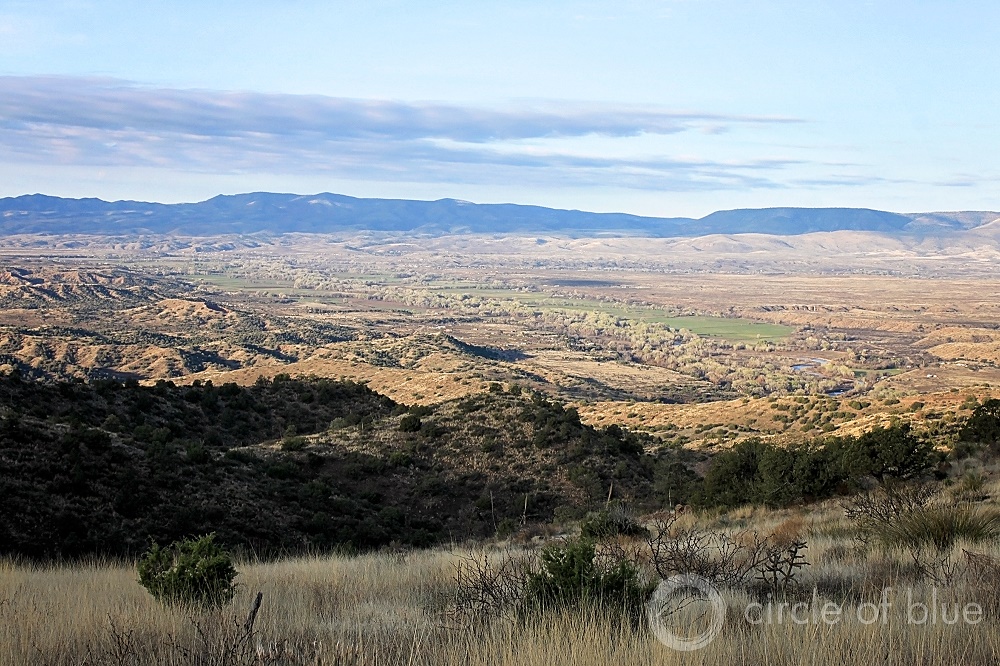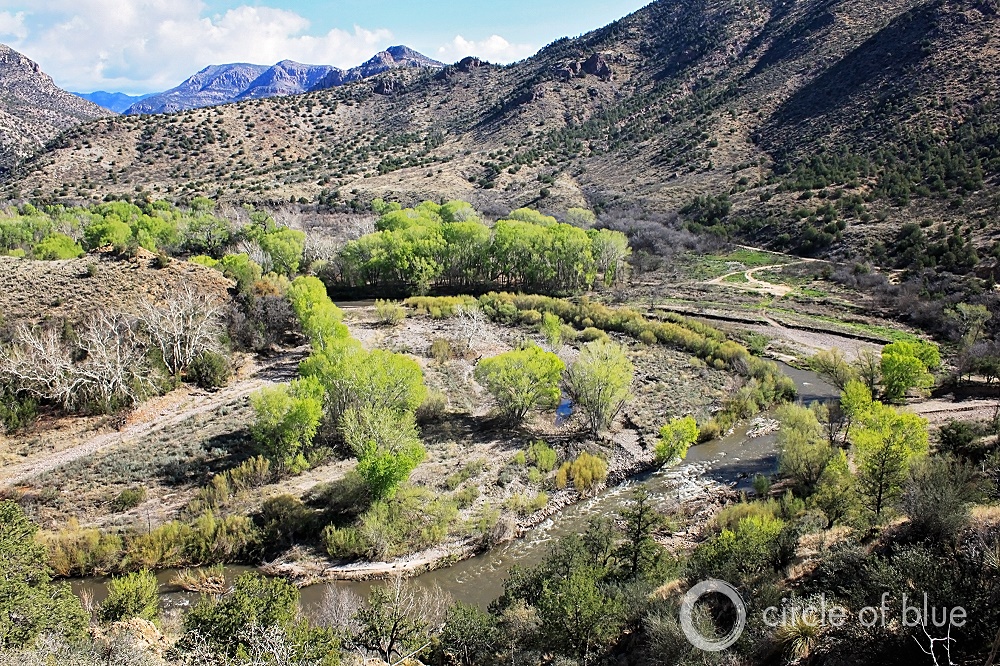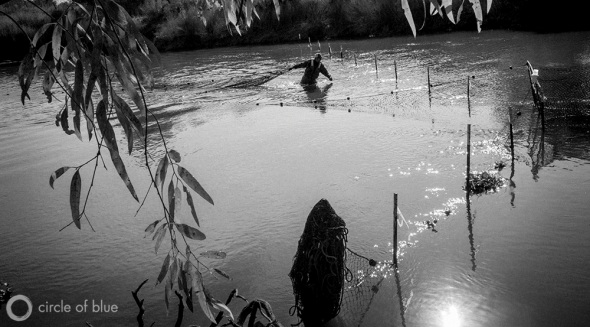Gila River Diversion Reaches Decision Point
Fate of an expensive Southwest water supply project is at stake

In several proposals under consideration, the Gila River, on the right of the image, would be diverted into reservoirs built in the canyons to the left. Click image to enlarge. Photo © Brett Walton / Circle of Blue
By Brett Walton
Circle of Blue
Southwest New Mexico awaits one of the most significant federal decisions on water infrastructure and the environment in this region since the U.S. Forest Service designated 755,000 acres of the Gila National Forest in 1924 as the nation’s first wilderness area.
Interior Secretary Sally Jewell faces a November 23 deadline to authorize a procedural step that will allow the Gila River diversion, a network of dams, reservoirs, and pipelines at the doorstep of the magnificent Aldo Leopold Wilderness, to begin the environmental review process. But the diversion — which could cost more than $US 1 billion — also would disrupt the ecology of one of the few major undisturbed watersheds in the Southwest.The project is a potent symbol of the choices facing the drying American West as communities, governments, farmers, and conservationists struggle to apportion declining supplies of fresh water.
The secretary’s decision also represents another meaningful inflection point for the Obama administration’s environmental policy. The president and his aides have engineered an autumn of swift political pivots — the rejection of the Keystone XL pipeline, a presidential memo ordering that certain federal construction projects generate net ecosystem benefits, the cancellation of Arctic offshore oil lease sales, a plan to limit carbon emissions from coal-fired power plant, and calls to ban new fossil fuel leases on federal land. Now the head of the federal government’s largest public lands agency must make a potentially historic choice. She can continue the pursuit of a water project that follows the 20th century path of economic growth through the construction of big centralized infrastructure. Or she can reject the plan because it does not embrace the emerging development ethic of the 21st that recognizes ecological limits, and prizes conservation and efficiency.
Technically, Jewell is tasked with approving or rejecting a new operating unit of the Central Arizona Project, a federal canal that moves Colorado River water to the heart of Arizona. The New Mexico unit would finance and manage the Gila River diversion. But without Jewell’s authorization of the new unit, the project that it would orchestrate essentially dies as well, according to Adrian Oglesby, director of the Utton Center, which focuses on natural resources and water law in New Mexico. Lawsuits, however, would surely follow, he added.
That makes next Monday a day of keen interest for the state of New Mexico.
Deadline Approaches
Statements from the Interior Department indicate that Jewell will approve the New Mexico unit and proceed with an environmental review that is required under the 1969 National Environmental Policy Act.
“This project proposal requires an environmental review under the National Environmental Policy Act be initiated and completed before a final decision is made,” Leah Duran, Interior spokeswoman, wrote to Circle of Blue in an email.
When asked if this meant that the new unit would be approved, Duran wrote that she did not have any announcements to make regarding the project. She reiterated that any diversion would be thoroughly vetted and analyzed under the National Environmental Policy Act. According to the project’s authorizing statue, a final decision would be made between 2019 and 2030.
Other observers also conclude that Jewell is likely to approve the New Mexico unit and move the project into the environmental review stage. Oglesby said that the authority for an outright rejection, before an environmental review begins, is a question of legal interpretation. The statue that authorizes the New Mexico’s taking of Gila River water says that the agreement forming the unit “shall be executed” within one year of New Mexico stating its intent to do so.
“The question is,” Oglesby said, “is does ‘shall’ mean a mandate or simply a deadline that can come and go? I suspect that Interior will view the language as a secretarial duty because that’s the easier path. If the project were denied, there would be a pretty vehement response from New Mexico and the Interstate Stream Commission.” The Interstate Stream Commission is the state water planning agency.
Oglesby said that revisions made to the agreement this summer — stipulations that put in place stiffer environmental assessments and unit’s financial viability — give the federal government options to terminate the project down the road.
Project Advanced as a Political Pawn
Though its roots can be traced to the political horsetrading that led Congress to authorize the Central Arizona Project in 1968, a Gila diversion idea, in its current incarnation, developed over the last decade.

This bend of the Gila River, just downstream from the boundary of the Aldo Leopold Wilderness, is one proposed diversion point. Click image to enlarge. Photo © Brett Walton / Circle of Blue
In 2004, Congress approved the Arizona Water Settlements Act, the main purpose of which was to sort out tribal water rights in Arizona. The settlement included an inducement for New Mexico’s congressional delegation. New Mexico would get $US 66 million in 2004 dollars (now approximately $US 90 million) for water supply projects in four sparsely populated southwestern counties. The money could be used to line earthen irrigation canals, build a reservoir, patch leaky city pipes: any project that would increase water availability. A second pot of money, $US 34 million, is set aside for the capital cost of building a diversion. A third pot, roughly $US 28 million, would be available if a federal Colorado River Basin investment fund has enough money. The Bureau of Reclamation suggested this summer that it will not.
Nonetheless, on November 24, 2014, the Interstate Stream Commission decided that it wanted to go after the second and third pots. The commission notified the Interior Department that it intended to build a diversion.
That set in motion a series of deadlines that culminates on Monday, the end of the one-year window for Jewell to act. In the last 12 months, the ISC approved a joint powers agreement that established an agency that will manage and fund the New Mexico unit. Thirteen local agencies — four counties, three towns, and six irrigation districts — signed up. Several communities in the region, including Silver City, the second largest town, did not, rejecting the need for such a grandiose installation.
The project would not dam the Gila. It would siphon a portion of the river’s flow and store the water in reservoirs built in canyons adjacent to the main channel. To supply Deming — at 14,000 people it is the region’s largest town — the water would be pumped over the Continental Divide. The annual electricity bill to lift the water is estimated at $US 3 million.
Cost has been a critical concern. The four counties are home to just 62,000 people. Farmers are expecting a sizable share of the 14,000 acre-feet of water that the project is permitted to draw from the Gila, but would hardly be able to shoulder the bill. In June, the Bureau of Reclamation assessed the cost of 12 configurations of diversion points, reservoirs, and pipelines. Seven of the options topped $US 1 billion. The cheapest was $US 700 million.
In addition, the terms of the settlement agreement require New Mexico to replace the water it removes from the river. The state would do so by paying for an equivalent amount of Colorado River water to be delivered to the Gila River Indian Community in Arizona. The diversion, in essence, is a swap.
Altogether, the question of who pays and how is a significant obstacle. The Bureau of Reclamation in its analysis foresees the project built in phases as money becomes available. Financing plans do not yet exist.
“The local entities want to move forward with the project but no one wants to commit to the costs,” Allyson Siwik, executive director of the Gila Conservation Coalition, which opposes the project, told Circle of Blue. Siwik and other opponents cite a number of studies that indicate that the project will not yield the volume of water its boosters hope. A Nature Conservancy study looked at the river’s historic flow and concludes that only 85 percent of the permitted water would be available.
Supporters remain confident that the project is worth pursuing, if only because it is a rare opportunity for a dry state to tap a new water source. Despite widespread criticism, the Interstate Stream Commission (ISC) has steadfastly pushed ahead.
“The regional water deficit is not sustainable and left unaddressed, would lead to dire consequences for local economies and cultures. It would be irresponsible for the ISC to ignore the annual average of 14,000 acre-feet of additional water available to New Mexico in the 2004 Arizona Water Settlements Act,” Lela Hunt, ISC spokeswoman, wrote in a statement to Circle of Blue in May.
Environmentalists and fiscal hawks, representing national and state groups, organized a last-minute push to scuttle the project. On Tuesday, six groups, including American Rivers and the Audubon Society, submitted to the Interior Department more than 54,000 signatures and comments in opposition to the diversion, according to Siwik, whose organization also participated in the letter-writing campaign.
Brett writes about agriculture, energy, infrastructure, and the politics and economics of water in the United States. He also writes the Federal Water Tap, Circle of Blue’s weekly digest of U.S. government water news. He is the winner of two Society of Environmental Journalists reporting awards, one of the top honors in American environmental journalism: first place for explanatory reporting for a series on septic system pollution in the United States(2016) and third place for beat reporting in a small market (2014). He received the Sierra Club’s Distinguished Service Award in 2018. Brett lives in Seattle, where he hikes the mountains and bakes pies. Contact Brett Walton












Leave a Reply
Want to join the discussion?Feel free to contribute!